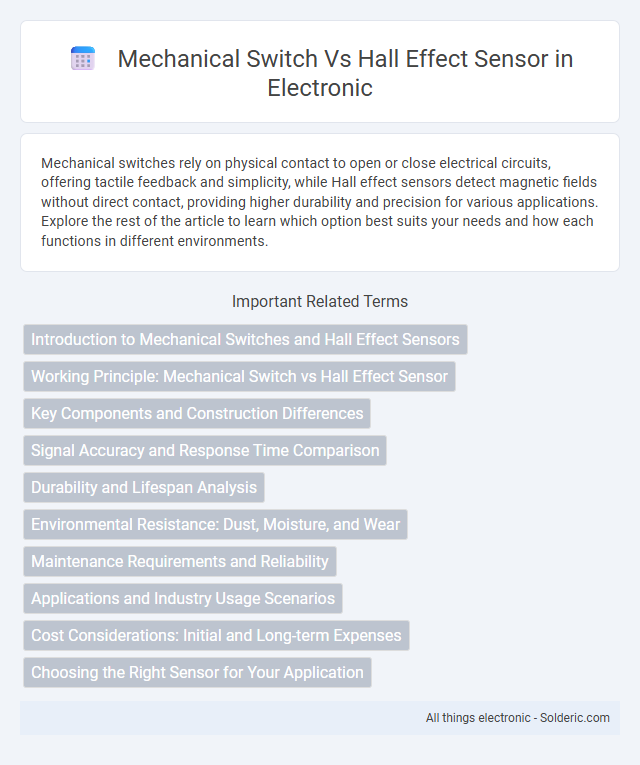Mechanical switches rely on physical contact to open or close electrical circuits, offering tactile feedback and simplicity, while Hall effect sensors detect magnetic fields without direct contact, providing higher durability and precision for various applications. Explore the rest of the article to learn which option best suits your needs and how each functions in different environments.
Comparison Table
| Feature | Mechanical Switch | Hall Effect Sensor |
|---|---|---|
| Operation | Physical contact closure | Magnetic field detection |
| Durability | Wear-prone due to mechanical use | High durability, no physical wear |
| Sensitivity | Limited by contact mechanism | Highly sensitive to magnetic fields |
| Response Time | Slower, debounce required | Fast, no debounce needed |
| Maintenance | Periodic cleaning and replacement | Low maintenance |
| Cost | Lower initial cost | Higher initial cost |
| Applications | Simple on/off controls | Position sensing, speed measurement |
Introduction to Mechanical Switches and Hall Effect Sensors
Mechanical switches rely on physical contact to open or close an electrical circuit, providing tactile feedback and reliable operation in various applications. Hall effect sensors detect magnetic fields without physical contact, offering high durability and precise position sensing in harsh environments. Your choice between these technologies depends on the need for mechanical simplicity or advanced non-contact sensing capabilities.
Working Principle: Mechanical Switch vs Hall Effect Sensor
Mechanical switches operate through physical contact between conductive parts, completing or breaking an electrical circuit by manual or mechanical movement. Hall effect sensors detect magnetic fields using the Hall effect principle, generating a voltage output proportional to the magnetic flux density without physical contact. The non-contact nature of Hall effect sensors offers enhanced durability and reliability compared to mechanical switches prone to wear and contact degradation.
Key Components and Construction Differences
Mechanical switches use physical contacts that close or open the circuit when pressed, relying on metal springs and conductive materials for operation. Hall effect sensors utilize a semiconductor chip and a magnet to detect changes in magnetic fields, offering contactless switching with no mechanical wear. Your choice depends on whether you prioritize tactile feedback and simplicity or durability and precision sensing.
Signal Accuracy and Response Time Comparison
Mechanical switches rely on physical contact to complete circuits, which can introduce debounce delays and signal inconsistencies due to wear or contamination, resulting in slower response times and reduced signal accuracy. Hall effect sensors use magnetic fields to detect position or motion, providing consistent, contactless operation with rapid response times often in the microsecond range and highly accurate signal output unaffected by mechanical wear. This makes Hall effect sensors superior for applications requiring precise, reliable detection and minimal signal latency compared to traditional mechanical switches.
Durability and Lifespan Analysis
Mechanical switches typically offer a lifespan of around 1 to 10 million actuations due to physical contact wear and tear, while Hall effect sensors provide significantly longer durability, often exceeding 50 million cycles, since they operate without direct mechanical contact. The non-contact nature of Hall effect sensors results in less mechanical degradation and resistance to environmental factors such as dust and moisture, enhancing overall reliability. This superior longevity makes Hall effect sensors ideal for applications requiring extended operational life and minimal maintenance.
Environmental Resistance: Dust, Moisture, and Wear
Mechanical switches are more susceptible to environmental factors such as dust, moisture, and wear, which can lead to contact degradation and reduced lifespan. Hall effect sensors, being contactless and sealed, offer superior resistance to harsh conditions, maintaining reliable operation even in dusty or moist environments. Choosing a Hall effect sensor ensures your device remains durable and consistent under challenging conditions.
Maintenance Requirements and Reliability
Mechanical switches often require regular maintenance due to physical wear, debris accumulation, and contact degradation, impacting long-term reliability. Hall effect sensors offer superior reliability with non-contact operation, minimizing mechanical wear and reducing maintenance needs significantly. This sensor technology ensures consistent performance in harsh environments, making it ideal for applications demanding durability and low upkeep.
Applications and Industry Usage Scenarios
Mechanical switches are widely used in consumer electronics, automotive controls, and industrial machinery where tactile feedback and simple on/off functionality are required. Hall effect sensors dominate applications needing non-contact, wear-free operation such as wheel speed sensing in automotive ABS systems, brushless DC motors, and robotics for precise position detection. Industries including automotive manufacturing, aerospace, and industrial automation rely on Hall effect sensors for their durability and high reliability under harsh environmental conditions.
Cost Considerations: Initial and Long-term Expenses
Mechanical switches typically come with lower initial costs due to their simple design and widespread availability, making them budget-friendly for short-term projects. Hall effect sensors, while more expensive upfront due to advanced semiconductor components, offer longer lifespan and reduced maintenance costs, resulting in better long-term value. Your choice should consider not only the purchase price but also durability and total cost of ownership over time.
Choosing the Right Sensor for Your Application
Mechanical switches provide reliable tactile feedback and straightforward integration for applications requiring simple on/off control, while Hall effect sensors offer contactless operation, enhanced durability, and precise position sensing ideal for environments with high wear or contamination. Consider factors such as operating environment, expected lifespan, and response accuracy to determine which sensor aligns with your specific application needs. Your choice impacts system performance, maintenance requirements, and long-term reliability.
mechanical switch vs hall effect sensor Infographic

 solderic.com
solderic.com